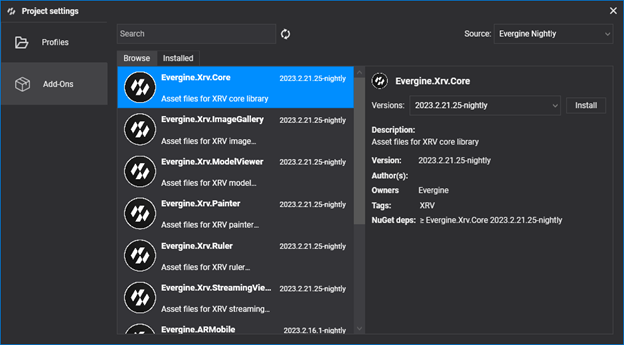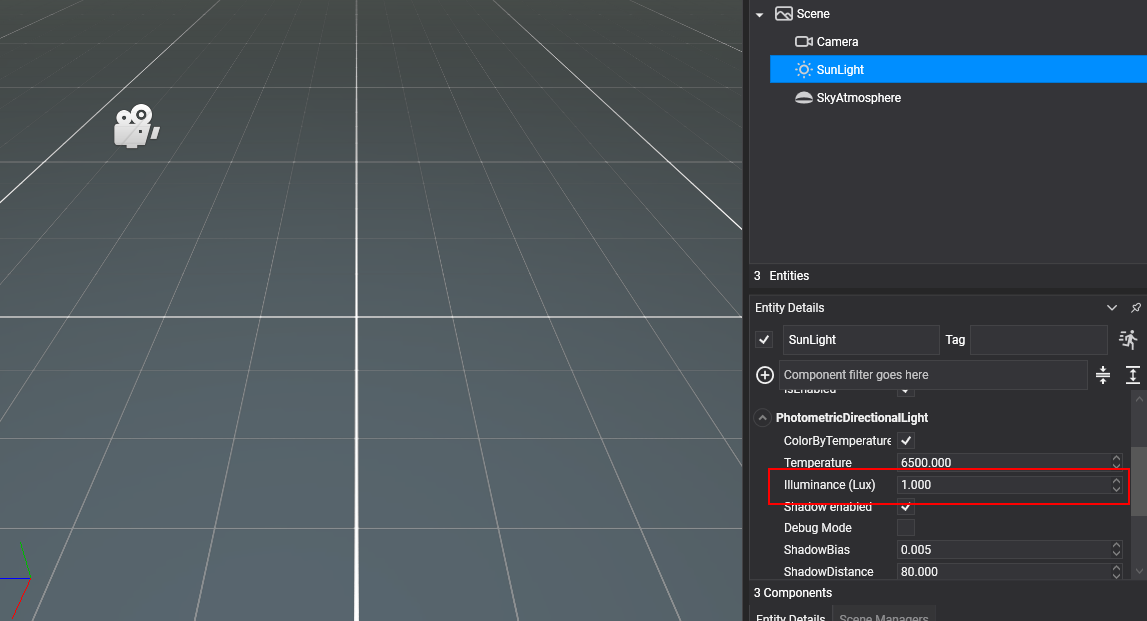Getting started
In this section we are presenting step-by-step instructions to be ready to execute XRV in your device.
Project setup
Create a new project using Evergine Launcher. You should include an extra template project, apart from Windows, for your target device. For example, with Meta Quest headset, you can choose between Xamarin and/or .NET 6 project templates.
Once Evergine Studio is opened, add a MRTK add-on. You can check how to add add-ons to an existing project.

With MRTK add-on installed, you need to add Evergine.XRV.Core add-on using project management dialog again.

Note
All XRV add-ons have an associated NuGet package. In the same way as Evergine packages, nightly builds of XRV are available on a public NuGet feed. Preview packages will be published in Nuget.org. So, for nightly builds, you should update your nuget.config file to include Evergine nightly feed:
<?xml version="1.0" encoding="utf-8"?>
<configuration>
<packageSources>
<add key="nuget.org" value="https://api.nuget.org/v3/index.json" />
<add key="Evergine Nightly" value="https://pkgs.dev.azure.com/plainconcepts/Evergine.Nightly/_packaging/Evergine.NightlyBuilds/nuget/v3/index.json" />
</packageSources>
</configuration>
- Change default scene SunLight entity value for Illuminance to a value of 1

Code setup
- Register background scheduler in your Application constructor.
public MyApplication()
{
this.Container.RegisterType<Settings>();
this.Container.RegisterType<Clock>();
this.Container.RegisterType<TimerFactory>();
this.Container.RegisterType<Random>();
this.Container.RegisterType<ErrorHandler>();
this.Container.RegisterType<ScreenContextManager>();
this.Container.RegisterType<GraphicsPresenter>();
this.Container.RegisterType<AssetsDirectory>();
this.Container.RegisterType<AssetsService>();
this.Container.RegisterType<ForegroundTaskSchedulerService>();
this.Container.RegisterType<WorkActionScheduler>();
BackgroundTaskScheduler.Background.Configure(this.Container);
}
- Change your scene class to implement XRScene.
public class MyScene : XRScene
{
protected override Guid CursorMatPressed => EvergineContent.MRTK.Materials.Cursor.CursorPinch;
protected override Guid CursorMatReleased => EvergineContent.MRTK.Materials.Cursor.CursorBase;
protected override Guid HoloHandsMat => EvergineContent.MRTK.Materials.Hands.QuestHands;
protected override Guid SpatialMappingMat => Guid.Empty;
protected override Guid HandRayTexture => EvergineContent.MRTK.Textures.line_dots_png;
protected override Guid HandRaySampler => EvergineContent.MRTK.Samplers.LinearWrapSampler;
protected override Guid LeftControllerModelPrefab => Guid.Empty;
protected override Guid RightControllerModelPrefab => Guid.Empty;
protected override float MaxFarCursorLength => 0.5f;
//...
}
- Add Microsoft.Bcl.AsyncInterfaces to shared project.
<PackageReference Include="Microsoft.Bcl.AsyncInterfaces" Version="7.0.0" />
- Finally, create XrvService instance and initialize it under OnPostCreateXRScene.
MyApplication.cs
public override void Initialize()
{
base.Initialize();
this.InitializeXrv();
// ...
}
private void InitializeXrv()
{
var xrv = new XrvService();
this.Container.RegisterInstance(xrv);
}
MyScene.cs
protected override void OnPostCreateXRScene()
{
base.OnPostCreateXRScene();
var xrv = Application.Current.Container.Resolve<XrvService>();
xrv.Initialize(this);
}
Platform setup
Android
In some platforms like Android, you may find build errors like this.
error XA2002: Can not resolve reference: `Evergine.Editor.Extension`, referenced by `Evergine.MRTK.Editor`. Please add a NuGet package or assembly reference for `Evergine.Editor.Extension`, or remove the reference to `Evergine.MRTK.Editor`.
Just add Evergine.Editor.Extension to your project and it should work.
Also, to make use of passthrough capability, remember to uncomment related parts of code in MainActivity.cs and in Android manifest file.
UWP (Mixed Reality)
In UWP you may find some PRI generation erros, that you can fix editing your project file and adding the following:
<AppxGeneratePrisForPortableLibrariesEnabled>false</AppxGeneratePrisForPortableLibrariesEnabled>
Also, if you add modules that require internet access or want to make use of voice commands, review that you enable Internet Client and Microphone capabilities. For voice commands, you should also add an explicit reference in Mixed Reality project to Evergine.Xrv.Core NuGet package.
Add more modules
With all this, you can run application, but the only thing you could do is open hand menu and its two default buttons to open Settings and Help windows. To add more functionalities, you can add any of the existing XRV modules, create your own module or just add new elements using XRV API.
You can also take a look to our XRV sample that includes all our public modules.